PREVENTING DISEASE
|
MAKING HISTORY
"I believe that the next twenty to thirty years are probably the most exciting and productive years we're going to have in improving health globally."
—D. A. Henderson, 2007
Smallpox is an infectious and sometimes fatal disease caused by the variola major virus. There is no known cure, but vaccination can prevent the development and
spread of the disease. In 1967, the World Health Organization (WHO) launched a global campaign to eradicate smallpox. Challenges included high costs, disagreements
over the most effective strategy, and differences in the health systems of various countries. Even so, within a decade the disease had been eradicated. The lessons
of this historic effort are vital for future vaccination campaigns.
ERADICATING SMALLPOX:
Dr. D. A. Henderson describes the international team involved in the campaign to eradicate smallpox.
Transcript
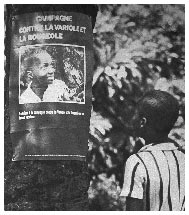 Learning about the smallpox eradication campaign, Mali, 1968
Learning about the smallpox eradication campaign, Mali, 1968Courtesy CDC Public Health Image Library
Led by Dr. D. A. Henderson, the campaign depended on the participation of thousands of people in many countries, including health workers and the
volunteers who were vaccinated. Although most people agreed to the procedure, some felt pressured by campaign workers. Others argued against the narrow focus on smallpox, when
many people would still fall ill due to hunger or malaria. The success of other disease eradication campaigns may hinge as much on the resolution of these issues as the development
of new vaccines.
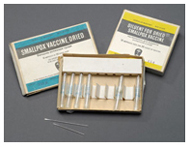 Boxes of dried smallpox vaccine and diluent with bifurcated needles, 1970s
Boxes of dried smallpox vaccine and diluent with bifurcated needles, 1970sCourtesy D.A. Henderson, M.D., M.P.H
A vaccine against smallpox was first discovered in 1796, but the disease was not eliminated in Europe and North America until the 1940s. Although many people involved in these
efforts were interested in eradicating the disease from the rest of the world, it was not until the 1960s that a comprehensive program was launched.
International collaboration and technological advances were critical to the success of the smallpox campaign. The Soviet Union first suggested a global effort, and donated more than eighty percent
of the vaccine needed. A freeze-dried vaccine that lasted a month replaced an earlier liquid version which had to be used within forty-eight hours. The bifurcated needle, invented in the 1960s, needed
only a small amount of vaccine and could be sterilized and reused many times.
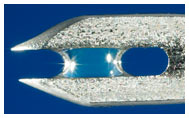 Close-up of a bifurcated needle, 2002
Close-up of a bifurcated needle, 2002Courtesy CDC Public Health Image Library/James Gathany
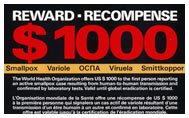 Reward for reports of cases of smallpox, World Health Organization, 1970s
Reward for reports of cases of smallpox, World Health Organization, 1970sCourtesy National Library of Medicine
Instead of trying to vaccinate everyone in each country, smallpox campaign staff would respond to outbreaks, isolate the infected persons to stop them from spreading the disease, then vaccinate all
of their close contacts and the people around them. Smallpox creates visible marks on the skin, making it easy to diagnose the disease and track infection. The World Health Organization (WHO) offered
rewards of one thousand dollars to encourage people to report new cases.
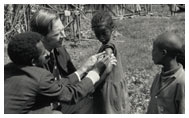 Dr. D. A. Henderson in Ethiopia, administering a smallpox vaccination, ca. 1972
Dr. D. A. Henderson in Ethiopia, administering a smallpox vaccination, ca. 1972Courtesy WHO
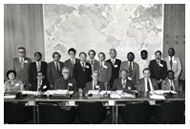 Dr. D. A. Henderson and members of the World Health Organization's Smallpox Eradication Program, 1979
Dr. D. A. Henderson and members of the World Health Organization's Smallpox Eradication Program, 1979Courtesy WHO
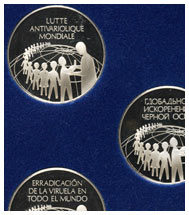 Medals in each of the five official languages of the United Nations, commemorating the global eradication of smallpox, 1978
Medals in each of the five official languages of the United Nations, commemorating the global eradication of smallpox, 1978Courtesy WHO Archives
The World Health Organization's Global Smallpox Eradication Program involved more than thirty countries and took nearly ten years. The campaign was declared a success in 1977,
and to commemorate the event, the United Nations (UN) commissioned a set of medals symbolizing children around the world receiving the smallpox vaccination. The medals were minted in the official
languages of the UN: Chinese, English, French, Russian, and Spanish.
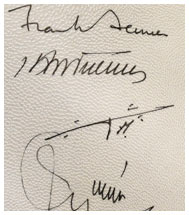 Certificate commemorating the eradication of smallpox, 1979
Certificate commemorating the eradication of smallpox, 1979Courtesy WHO Archives
Smallpox was eradicated in Europe and North America by the mid-twentieth century. By 1973, only five of the thirty-three countries where the disease had been endemic still had outbreaks of smallpox.
With the success of the campaign in 1977, smallpox became the first major disease to be eliminated from the globe.
Next
 Learning about the smallpox eradication campaign, Mali, 1968
Learning about the smallpox eradication campaign, Mali, 1968 Boxes of dried smallpox vaccine and diluent with bifurcated needles, 1970s
Boxes of dried smallpox vaccine and diluent with bifurcated needles, 1970s Reward for reports of cases of smallpox, World Health Organization, 1970s
Reward for reports of cases of smallpox, World Health Organization, 1970s Medals in each of the five official languages of the United Nations, commemorating the global eradication of smallpox, 1978
Medals in each of the five official languages of the United Nations, commemorating the global eradication of smallpox, 1978


